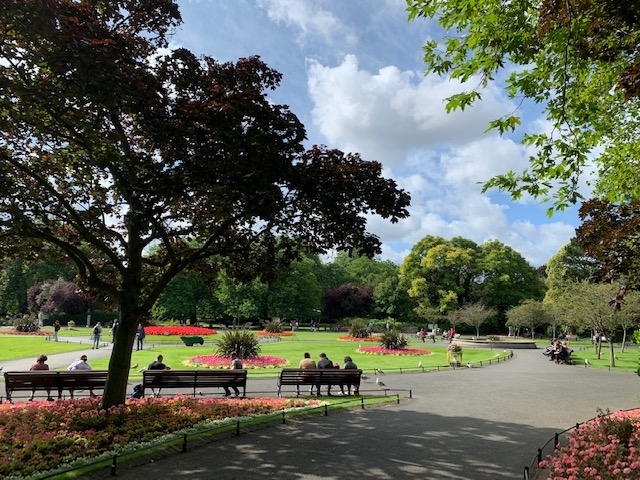October 27, 2019 - By Janet Hartin, Author - Area Environmental Horticulture Advisor and County Co-Director - Landscape trees provide shade, reduce interior energy use and related costs, and beautify our communities. They also help clean our environment by absorbing carbon dioxide emitted by vehicles and other producers of fossil fuels. Taking care of your trees is an important way to maximize these benefits.
Here are some ways you can help ensure a healthy tomorrow:
- Remove any tree ties that are cutting into the trunk or branches of your trees. If trees must be staked due to windy conditions, make sure that the ties are loose enough to allow trees to gently flex in the wind. This helps trees develop the necessary lower trunk strength and stability to support the tree as it matures. Over time, you may be able to completely remove the ties and stakes once the lower trunk becomes stronger and self-supporting.
- Keep all plants and mulch several inches away from tree trunks.
- Keep tree trunks dry. They should not come into contact with water from sprinklers or hoses.
- Water mature trees infrequently and deeply. Watering too often reduces the level of oxygen in the rootzone and can lead to waterlogged soils prone to crown and root rots. During fall, trees require only about 15% of the water they required in the summer.
- Prune trees only as needed and avoid topping them. Invest in the services of a credentialed and knowledgeable professional to correctly care for your valued trees. Find a list of International Society of Arboriculture Certified Arborists in your area here: https://www.treesaregood.org/findanarborist
- Identify and correct problems due to diseases, insects, or non-living (abiotic) disorders early. Most of the time, these problems are due to poor drainage or other soil/water management issues rather than pests.
Here is a lengthier article with additional photos I recently wrote for Parks and Recreation Business Magazine.

Do you want to plant a new tree? Make sure you have adequate space. Large growing shade trees require up to 3,000 cubic feet of underground space and should not be planted under power lines. Smaller drought resistant trees that are better choices under these conditions include some cultivars of acacia, palo verde, redbud, and toyon.
SelecTree: This searchable database is maintained by the Urban Forest Ecosystems Institute at California Polytechnic State University, San Luis Obispo. Users may search multiple criteria to select trees based on climate zone, ultimate height and width, above and below ground space requirements, root damage potential, water requirement, flower characteristics, disease, insect susceptibility, and other criteria.
Water Use Classification of Landscape Species: This searchable database is maintained by UC ANR and classifies over 3,500 woody and herbaceous landscape plants into very low, low, medium, and high water-use categories based on the observations of regional committees consisting of knowledgeable horticulturist combined with research-based data when available.
CalScape: This searchable database is maintained by the California Native Plant Society and contains thousands of woody and herbaceous plants listed by city and other criteria such as plant type, flower color and season, water use, ease of care, use, and nursery availability.
For additional assistance with your landscape questions, contact:
UCCE Master Gardener volunteers in your county: http://mg.ucanr.edu/FindUs/
Local nurseries and garden centers in your area: https://plant.cdfa.ca.gov/nurserylicense/nlscanp.asp
Source: UC ANR








